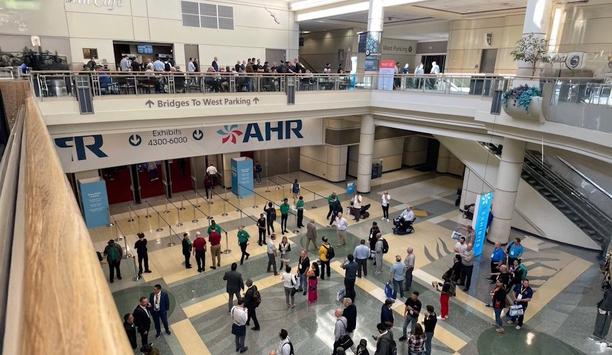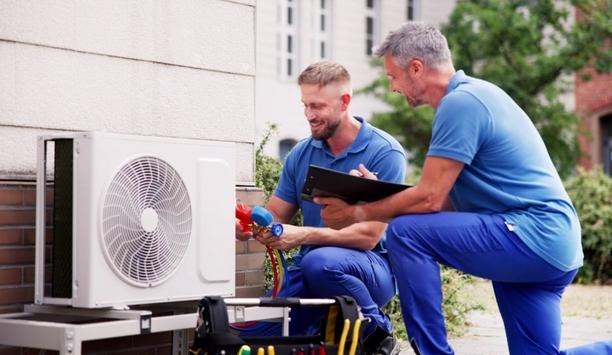How can UK businesses effectively tackle the challenge of cooling commercial and industrial buildings? Cooling commercial and industrial buildings can be a challenge for UK businesses. In recent years, the spiraling energy costs have put pressure on businesses with regard to finding new and innovative ways to achieve the same result with less capital outlay and less maintenance.
New system installs have sometimes been put on hold and maintenance schedules squeezed, leaving many businesses with the challenge of managing aging HVAC assets and deciding when and where to invest. Systems without regular maintenance can experience unpredictable downtime and parts availability is not always guaranteed.
Evaporative Cooling
Evaporative cooling is an alternative cooling method that not only offers higher energy efficiency
Business owners will always wonder how they can improve the cost-effectiveness, ease of maintenance, and sustainability of systems their business needs. When it comes to cooling business premises, there’s a solution that not enough people know: Evaporative Cooling.
Evaporative cooling is an alternative cooling method that not only offers higher energy efficiency than alternative HVAC solutions but also has cheaper running costs. Since then, it has been our mission to develop and use this technology to tackle the cooling challenges in industrial processes.
Cooling Challenges in Industrial Processes
With regard to cooling, many industrial processes have a high heat gain, whereby the process itself generates heat which must be managed. There are numerous sectors where this is occurring, two prime examples from our customer experience are industrial-scale bakeries and plastic molding facilities.
The production line may be operational 24 hours a day, seven days a week
In an industrial-scale bakery using modern production methods, the production line may be operational 24 hours a day, seven days a week. The constant production of heat and steam from large ovens working to high temperatures must be managed carefully, especially given the health and safety requirements for food production areas.
Heat gain from the industrial processes
Plastic molding facilities manufacture a variety of end products from everyday items such as plastic bottles for household goods to more specialist storage and packaging products. In a plastic molding facility heat is used to mold the liquid plastic but chemical particles may also need extraction to maintain a safe working environment. Production in any of these facilities may be adversely affected by the heat gain in the process itself. Unplanned and unmanaged heat in any manufacturing facility has the potential to stop production resulting in a cascade of business interruption, lost revenues, damaged stock, and missed productivity targets. All potentially severe impacts for any business to consider.
 |
| Plastic molding facilities manufacture a variety of end products. |
In addition to heat gain from the industrial processes, we should also note that UK air temperatures are rising, the top 10 warmest years for the UK since records began in 1884 have all occurred since 2002. As the UK continues to experience temperature rises and more seasonal fluctuations we need to look to those more experienced with warmer climates to optimize and improve our own approach to cooling these spaces. So, let’s consider the choices to cool large commercial and industrial spaces.
Conventional air conditioning (AC) systems
Cotton mills and textile plants were among the early adopters of the technological advancement
Most of us will be familiar with conventional air conditioning (AC) systems but let’s review how they work: The first “modern” air conditioning unit was built by the American inventor Willis Carrier in 1902 and was used to control the temperature in the Sackett-Wilhelms Lithographing & Publishing Company in Brooklyn, New York. This innovation helped to control the paper dimension and ink alignment. Cotton mills and textile plants were among the early adopters with the technological advancement soon spreading across the world.
Today a conventional AC unit removes heat and moisture from the air. It uses a chemical refrigerant to cool the air which is then re-circulated in the building. The same air is then filtered as it returns to the unit.
Key Facts of Conventional Air Conditioning
- Temperature can be controlled.
- Air is mostly recirculated within the space or building.
- The resultant energy performance of the system can be negatively impacted by high external temperatures, i.e., the hotter the external temperature the greater the amount of energy needed to run the unit and maintain the desired temperature.
- Complete systems are expensive to install and maintain due to the more complex requirements associated with the refrigerants used within the units.
- The cost to run large systems is expensive resulting in high and unpredictable energy bills.
- Chemical refrigerants are used ultimately negatively contributing to climate change.
Conventional air conditioning cannot be said to be a bad choice however, in our experience, it is more suited to smaller spaces with a defined use. Office spaces would be a good example of where air conditioning systems can still be a good solution albeit without the benefit of reduced running costs.
A fantastic sustainable alternative to conventional air conditioning is an evaporative cooling system. Historically championed in warmer climate countries, the technology delivers several benefits over and above conventional and familiar air conditioning.
Evaporative Cooling Solutions
Fresh, filtered air enters the system and is pulled through a cooling pad
Reflecting on global history, examples of evaporative cooling can be seen as far back as 1350AD. One case describes how in Cairo, Egypt, a building was purposely situated up-wind, to catch the air and let it flow down the building and across a fountain which increased the relative humidity and lowered the temperature of the surrounding air. A fascinating early adoption of the evaporative cooling effect.
Evaporative cooling systems as the name suggests use evaporation to cool the air; surprisingly no chemical refrigerants are involved in this process. Fresh, filtered air enters the system and is pulled through a cooling pad where the heat is absorbed. The resultant cooled air is distributed throughout the space via ducts.
Key Facts of Evaporative Cooling
- Temperature and humidity can be accurately controlled.
- Indoor Air Quality (IAQ) is improved because of the introduction of 100% fresh outside air this in turn improves employee comfort, health, and well-being and supports good productivity.
- Cooling performance is improved with increasing external temperatures–efficiency rises along with the temperature.
- Initial capital outlay costs are relatively low, in comparison to a like-for-like conventional air conditioning system.
- Running costs are low, lowering energy bills and energy dependence.
Based on the evaporation principle and using only water to cool, combined with the lack of chemical refrigerant make evaporative cooling a responsible, energy-efficient, and sustainable choice for cooling your industrial or commercial workplace.
Lowering Carbon Footprint with Evaporative Cooling
The carbon footprint is a method of determining environmental impact
Lower your business carbon footprint with an evaporative cooling system. When measuring a carbon footprint, it’s the amount of carbon dioxide directly or indirectly produced. The carbon footprint is a method of determining environmental impact. If an industry appliance uses a low level of electricity, it minimizes the environmental impact. Evaporative cooling systems can contribute to lowering the carbon footprint of your factory and warehouse in the following ways:
- Evaporative cooling products can use up to 82% less energy compared with conventional air conditioning. This is a huge saving both initially and across a lifespan of more than 15 years.
- Evaporative coolers also consume up to 30% less water than conventional AC systems despite relying on water to provide evaporation for the cooling effect!
Addressing Industrial Hotspots
In addition, industrial manufacturing workplaces often have hot spots that are uncomfortable to work in and those spaces are not just hotter than the rest of the building, but hotter than external ambient conditions. Evaporative cooling may be used to “spot cool” these hot spots and therefore reduce the need for the multiple units that would be needed to cool the entire space. Evaporative cooling is a proven technology perfect for all kinds of HVAC applications across multiple industries, this includes manufacturing plants and commercial warehouses.
When cooling these large areas, evaporative cooling is repeatedly more cost-effective than traditional air conditioning. The primary benefit being the initial capital outlay to design and install the system is lower than conventional air conditioning. Secondly, the day-to-day running costs are again less owing to the reduced energy demand by the sophisticated technology used in these coolers. Unusually, these cost savings are also underpinned by the eco-friendly credentials of the technology, potentially contributing to reducing the carbon footprint of your business. This can be further enhanced by installing supportive clean energy technology such as solar power.



















